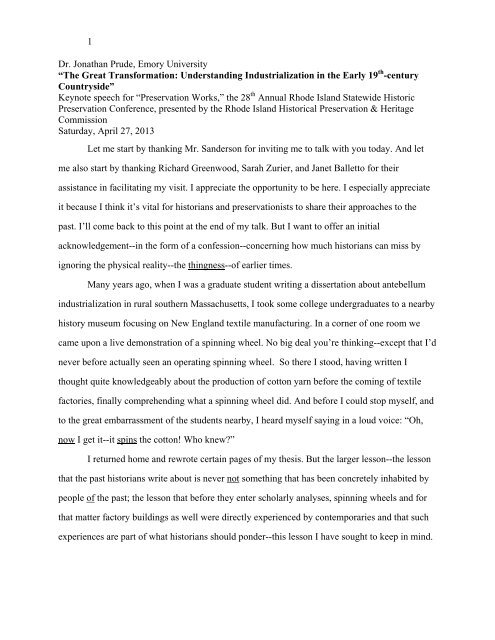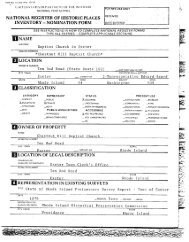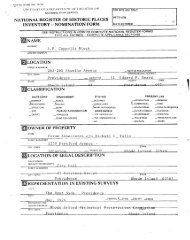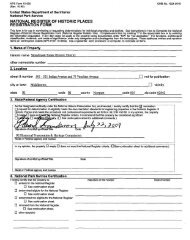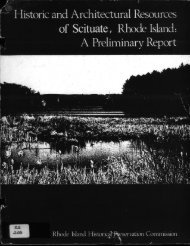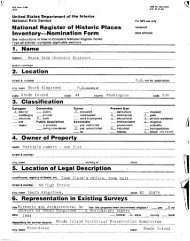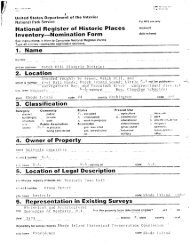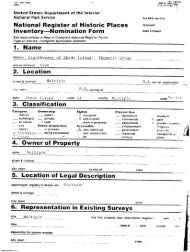1 Dr. Jonathan Prude, Emory University “The Great Transformation ...
1 Dr. Jonathan Prude, Emory University “The Great Transformation ...
1 Dr. Jonathan Prude, Emory University “The Great Transformation ...
You also want an ePaper? Increase the reach of your titles
YUMPU automatically turns print PDFs into web optimized ePapers that Google loves.
1<strong>Dr</strong>. <strong>Jonathan</strong> <strong>Prude</strong>, <strong>Emory</strong> <strong>University</strong><strong>“The</strong> <strong>Great</strong> <strong>Transformation</strong>: Understanding Industrialization in the Early 19 th -centuryCountryside”Keynote speech for “Preservation Works,” the 28 th Annual Rhode Island Statewide HistoricPreservation Conference, presented by the Rhode Island Historical Preservation & HeritageCommissionSaturday, April 27, 2013Let me start by thanking Mr. Sanderson for inviting me to talk with you today. And letme also start by thanking Richard Greenwood, Sarah Zurier, and Janet Balletto for theirassistance in facilitating my visit. I appreciate the opportunity to be here. I especially appreciateit because I think it’s vital for historians and preservationists to share their approaches to thepast. I’ll come back to this point at the end of my talk. But I want to offer an initialacknowledgement--in the form of a confession--concerning how much historians can miss byignoring the physical reality--the thingness--of earlier times.Many years ago, when I was a graduate student writing a dissertation about antebellumindustrialization in rural southern Massachusetts, I took some college undergraduates to a nearbyhistory museum focusing on New England textile manufacturing. In a corner of one room wecame upon a live demonstration of a spinning wheel. No big deal you’re thinking--except that I’dnever before actually seen an operating spinning wheel. So there I stood, having written Ithought quite knowledgeably about the production of cotton yarn before the coming of textilefactories, finally comprehending what a spinning wheel did. And before I could stop myself, andto the great embarrassment of the students nearby, I heard myself saying in a loud voice: “Oh,now I get it--it spins the cotton! Who knew?”I returned home and rewrote certain pages of my thesis. But the larger lesson--the lessonthat the past historians write about is never not something that has been concretely inhabited bypeople of the past; the lesson that before they enter scholarly analyses, spinning wheels and forthat matter factory buildings as well were directly experienced by contemporaries and that suchexperiences are part of what historians should ponder--this lesson I have sought to keep in mind.
2And it’s a lesson preservationists surely help teach--for teaching that lesson is surely also part ofhow preservation works.Thus my opening confession. I will, as I say, return later to some thoughts on connectionsbetween historians and preservationists. But let me turn now to what I suspect Mr. Sandersonhoped I’d provide when he issued his invitation: not the story of personal epiphanies but anhistorian’s perspective on early industrialization in New England--and more specifically onindustrialization in southern New England, in communities like West Warwick and others spreadthrough the Pawtuxet Valley and beyond, from the late 18th century to roughly 1850.First, some background considerations. I’m using the term “industrialization” rather than“Industrial Revolution” to stress that what happened was not some one-off event but an evolvingprocess. And I’m further underscoring the breadth of what happened by calling it <strong>“The</strong> <strong>Great</strong><strong>Transformation</strong>,” a rubric I’m invoking to signal industrialization’s extensive cultural, politicaland economic ramifications.Still, for all its reach, industrialization was not everything. For my purposes, the marrowof “industrialization,” the core phenomenon as distinct from its multiple consequences, involveda shift in manufacturing, in the making of goods. More specifically, it involved markedlyaccelerating divisions of labor by which the fabrication of products was increasingly choppedinto sub-tasks, often allotted to relatively unskilled workers, with the result that more could beproduced more cheaply. Responding in some cases to rising consumer demand and in all cases tomounting quests for profits, industrialization reflected and contributed to a stiffening capitalistgrip over America’s political economy. At the same time, industrial manufacture contrasted toartisanal or handicraft production by which individual items were fashioned as a whole, fromstart to finish, by laborers schooled to one or another degree in all the skills of a trade. Of course,the line between handicraft and industrial production was not always neat. But construingindustrialization as pivoting centrally around heightened divisions of labor allows us to recognizea process that gained traction in the United States, especially in the North, between theRevolution and the Civil War.
3It also allows us to realize industrialization took different forms. It might involve largecentralized manufactories (sometimes called “factories”) or small shops. It might involvecombinations of central workplaces and outworkers toiling in scattered satellite locations,including their homes. It might unfold with or without new technologies, or with technologiesadded only late in the game. It could emerge in urban settings--like New York City which hostedrelatively unmechanized but meticulously sub-divided ready-made clothing businesses. And itcould emerge in the northern countryside, which in these years hummed with the industrialproduction of clocks and palm-leaf hats, shoes and furniture, books and buttons. And also, ofcourse, with the production of textiles. Because if the textile manufactories springing up in theseyears demonstrated their industrial credentials with intricate divisions of labor, they likewiserepresented a form of industrialization that often did depend on machines--and often onmachines driven by the waterpower supplied by streams crisscrossing the northeasterncountryside.Country textile mills were in fact the dominant face of industrialization in southern NewEngland and hence key to the <strong>Great</strong> <strong>Transformation</strong> of this terrain. And they will loom large inmy discussion. But as a further piece of background, we need to appreciate that the mills ofsouthern Massachusetts, Connecticut, and Rhode Island in these years had particular features.They were different, for example, from what surfaced in Philadelphia, where textile productiontook root in mechanized but modest shops linked to urban outworkers. Southern New Englandmills also differed from the famous Waltham-or Lowell-style factories. Inaugurated in 1814 andprominent in northern New England, these mills were typically sizable, heavily capitalized, andincorporated enterprises launched in hinterland communities--but communities which soonurbanized. Committed from the outset to mechanized production of both yarn and cloth,Watham-style mills were further characterized by an initial ambition to recruit workforcescomprised mainly of single young women. By contrast, the textile operations of southern NewEngland--operations that had actually introduced water-powered textile production to America inthe 1790s when Samuel Slater launched his Pawtucket venture, but operations that were then
4reiterated along the Blackstone, and other southern Yankee waterways--these operationsfollowed the Rhode Island or family system. Unlike the Philadelphia model, they were typicallyfull-fledged mills. But unlike Waltham-style factories, they were sited in townships thatremained rural well into the 1800s, were comparatively small and organized as partnerships,were at first often devoted only to producing yarn, and started out hiring both individuals andfamilies.Over time, it’s true, these three versions of textile manufacturing tended to converge. Butunderstanding the <strong>Great</strong> <strong>Transformation</strong> in early nineteenth southern New England requiresunderstanding that, for all their incontestably weighty influence, the region’s textile mills wereultimately just one thread of industrialization bubbling up in the milieu and, further, just onemode of industrialized textile manufacturing evident in the Republic of these years. On the otherhand, these mills were powerfully influential. And we should turn now from backgroundconsiderations to exploring precisely what their influence was. What difference did the RhodeIsland-style factories make? We might answer this question by noting that the cotton they andother northern mills imported from the South and the textile products they shipped across theRepublic helped shape the economic connections of the early nineteenth century nation. Or wemight note that the machinery these and other textile factories adopted fostered importanttechnological innovations throughout America. But what I want to consider is something else.What I want to consider is the effect of these mills on the places and people they touched mostimmediately. What I want to consider is the effect of rural Rhode Island-style mills, first, on thetownships in which they took root and, second, on their employees. What I want to consider isthe local <strong>Great</strong> <strong>Transformation</strong> fueled by these factories.Now to open this focused-down part of our inquiry we naturally need to take up whatsouthern New England rural communities were like before the mills. For the most part--and I’mdrawing on my earlier work on the southern Massachusetts townships of Dudley, Oxford, andWebster--they were grounded in what be termed agriculture plus. They contained grist millersand storekeepers; and they contained handicraftsmen like carpenters and blacksmiths. But these
5individuals were typically also farmers, for agriculture was the fundament. The nature of farmingvaried. But it was generally carried out by land-owning households cultivating fruits, grains, anddairy products meant for their own consumption but with small surpluses sold or traded for theservices noted above or for goods available at local stores. In sum, the farming-anchoredhouseholds of these communities mixed limited engagements in the market with readiness toprovide for themselves--so, for example, after acquiring (or perhaps producing) wool and flax)they not uncommonly spun their own yarn (Figure #1) and wove their own cloth.The people of these communities were principally native-born Protestant whites, alongwith perhaps a few slaves (until formal emancipation took effect) and free blacks. Taken as awhole, local populations were hardly egalitarian, for there were clear gradations of affluence andstatus extending from prominent individuals and families to those of lesser standing and down tothe outright needy. On the other hand, the townships were for the most part run by townmeetings in which enfranchised adult males selected their leaders and administered communityaffairs. Nor for that matter did local wealth necessarily signal economic power. Credit wasbroadly present but also broadly shared, so that debtors were also creditors. What’s more, it wasrare for large cohorts of individuals to toil for others as waged employees. The stores andhandicraft workshops may have had paid workers, but only a few. And while farming householdsmight take on extra hands during harvests or to aid in domestic chores, such assistance wereusually structured more as labor swaps or exchanges among relatives than as formal hirings.We should note, too, that the households themselves generally functioned as corporateunits operating under the authority of husbands and fathers. There were female tasks (likecooking, spinning, and weaving), and male work (like outdoor farming jobs). But farmingfamilies characteristically sought to bend their members’ energies toward patriarchally-definednotions of collective wellbeing. And the wellbeing attaching to these households wascharacteristically simply to remain farming households. Aligned with their semisubsistence/semi-commercialorientation, their priority was not to maximize gain so much as to
6secure what was termed a “sufficiency,” not to get-ahead but to retain their holdings and hencetheir place within New England husbandry.Thus the world of southern New England rural communities in the late 18th and early19th centuries. But this world was also beset by important destabilizing pressures. To start with,there was the growing pull of commerce. Because notwithstanding their desire for sufficiency, itwas becoming increasingly attractive to buy services from others and, especially, to buy goodsfrom stores. And there was consequently growing need to generate the added income to coverthese added purchases--a challenge exacerbated for farmers because even those inclined to sellmore crops in the market were not certain their long-used land could generate greater yields orproduce items that would attract more customers. By the same token, the slow but steadypopulation growth of these communities was pressing against fixed land supplies, so that manyfamilies were finding it impossible to bequeath viable homesteads to all their children. The resultof this demographic pressure was in some cases a greater emphasis on the non-agriculturalventures in these townships. But the result was also movement--either to cities or to new landfurther out in the hinterland. Natural increase and infusions of newcomers (often to run the localstores and handicraft shops) ensured net increases of local residents. But at least by the early1800s the northeastern countryside, including the countryside of southern New England, wasmarked by chronic restless movings-about.All this--the need for more income, the uncertainty about farming outputs, the transiency--all these pressures, I’d suggest, invested rural Yankee communities with a certain deep fragilityand doubt. How could they preserve their heritage of husbandry and in truth any continuingsense of themselves amidst the buffeting shifts of life and work engulfing them?One answer, significantly, was industrialization. Now on the one hand the spread ofindustrialized manufacturing helped provide the very goods fostering the unsettling desire ofcountry folk for store-bought “stuff.” In truth, the spread of industrially produced goods into thehinterland may have fostered a measure of material democratization whereby items--clocks, say--hitherto available only to the rustic wealthy were now produced sufficiently cheaply to come
7within reach of at least middling sorts. But hardly less important was that the spread of ruralindustrial manufacturing itself into the countryside provided new employment opportunities andso new reasons for people to enter or stay within rural townships. The employment might beinside manufactories. But it might also involve participation in the outwork networks industrialproduction often fostered. It might, that is, involve participating in systems by which parts ofshoe or palm-leaf hat fabrication, for example, were given out to members of farminghouseholds--usually wives and daughters--to be worked up and then returned to central locations.Nor was it difficult to view textile mills in this light. For if they obviously helped diffusemanufactured textile goods across the countryside, they also provided employment. And againtheir employment ranged from workers inside the manufactories to others--with these others inthis case including local artisans serving the mills’ technologies and construction needs and, atleast at first, impressive flocks of outworkers. Rhode Island-style factories often started out usingoutworkers (once more mainly females) to prepare wool and cotton for their machines by“picking” it clean. And since many of these factories, even early on when they limitedthemselves to spinning operations, aimed to market cloth as their end product, they commonlycombined their water-powered spinning of yarn with networks of outworking handloom weavers(again mainly women) laboring in their homes. In their first few years of existence, the southernMassachusetts mills I studied employed some 150 pickers and more than 700 handloom weavers,with the latter contingent spilling into 29 townships in three states and covering some 800 squaremiles. (Figure #2) And then, as a vital added bonus, the workers inside mill buildings comprisedready consumers for the foodstuffs produced by nearby husbandmen.In these ways, for these reasons, the presence of industrial enterprises in rural townshipslike those of southern New England might well have seemed a solution to vexing problems. Forworking inside these enterprises might well have appeared to offer employment capable ofoffsetting eroding husbandry, while the outwork wages and foodstuff-customers these sameenterprises provided to farming families might well have seemed to offer ways for suchhousehold both to continue farming and pay their mounting bills.
8But gauging what industrialization meant to the southern New England countrysiderequires realizing that this multi-faced process was controversial. Here, it’s true, we need toconnect local developments with wider contemporary currents. Because what happened in thecommunities of this region was importantly framed by contesting attitudes swirling across theNortheast--and indeed the nation.Thus, on one side, Thomas Jefferson early on urged that Americans preserve the virtuousindependence central to republicanism by remaining landholding husbandmen rather thansuccumbing to the dependency of wage labor, including industrial wage labor. “While we haveland to labor, then,” ran his famous late eighteenth century pronouncement, “let us never see ourcitizens occupied at a work bench...[L]et our work-shops remain in Europe.” As the UnitedStates moved into the 19th century, antipathy to waged hirelings was supplemented by stories ofhorrid conditions festering in English factory cities--conditions frequently contrasted to thisnation’s splendid natural vistas. In fact, combined with the spiritual impulses of the Second <strong>Great</strong>Awakening, salutes to scenery in America molted into outright sacrilzations of the Americanrustic. The notion grew that nature in America was particularly imprinted with the Divine, a“lecture...bound by the Almighty,” and that--consequently--the nation bore special responsibilitynot to permit its hinterland to devolve into ghastly encampments of urban industrialization.Further cautionaries involved worry that employment inside manufactories would pulltoo many people from husbandry. “Oh, sir, my boys have all left me and turned shoe-peggars,”ran a lament in the Old Farmer’s Almanack in the 1830s. “If this is the way things are going on,our farms must soon run up to bushes.” There was worry, too, that the opportunity to sell toindustrial employees might pull farmers too far into the market, causing them to surrender theircore value of striving for sufficiency rather than gain, of foresaking the prosperity that (as onewriter had it) “money cannot purchase, and money cannot measure...” And there were suspicionsthat outworkers living at home were evincing unsettling new autonomy. For there were whispersof outworkers coming to believe that the wages they received from weaving or toiling on palmleafhats were theirs and should be used as they wished rather than surrendered to the corporate
9needs of the family. Since, moreover, many of the outworkers purportedly exhibiting suchattitudes were females--the wives and daughters shouldering much industrial outwork in this era--this emergent autonomy carried the added bite of appearing to question the patriarchy of ruralfamilies.Perhaps not surprisingly, there were answers to at least some of these anxieties.Jefferson’s warning against shedding the independence of husbandry was countered byarguments that for the nation as a whole “independence and security” actually necessitatedexchanging dependence on European workshops for reliance on America’s own manufactories.From another angle, the fact that many of America’s early industrial enterprises, particularlyenterprises like textile mills that required hinterland water power, were located in thecountryside--this fact was woven into an argument that if America was exceptional because of itsDivinely-touched Nature, it was also exceptional because here, on this side of the Atlantic,industrialization often proceeded not in grim cities but amidst the country’s blessed countryside.There were even pictorial formulations of this position. For textile factories came to be imagednested within a safe middle landscape: a zone between foreground and background thatpresented mills as comfortably integrated within the countryside--as neither destructivelydominating nor immune from the leavening inspiration of fields and valleys (Figure #3). And bythe same token there were suggestions that encounters with industrial operations would bring farmore benefit than harm to Yankee farmers. Female outworkers might grow restive. Buthusbandmen were told that selling crops to nearby mills would promote efficiency and that eventhe internal organization of factories might provide yeomen with salutary lessons inmanagement. “For within...a single textile mill,” a contemporary pamphlet concluded,“there ismore...skill and science...than in a township of farms.”In the end, of course, these upbeat arguments were further, and powerfully, bolstered bythe prospect of profits. For in the sector of the economy involved with industrialization,entrepreneurs and their allies were not hampered by worries about excessive devotion to gettingahead. On the contrary, in this sector of the economy there was no hesitation to embrace the
10priority of profits. And facilitated where needed by technological innovations, as well as by hopeindustrial manufacturing could benefit rural communities, the lure of earning profits frommaking shoes, hats, or textiles prompted substantial industrial development in the southern NewEngland countryside. By 1819, as many of you know, there were 40 textile mills running off thePawtuxet River alone; and by 1832 the Blackstone was driving 119 such factories. One mighteven argue that over time some of the skepticism directed toward the changes wrought by ruralindustrialization devolved into merely ventings of nostalgia that gave country folk psychologicalcover to accept the inevitability of these changes. Yet the skepticism did not vanish. It wasbraided into the atmosphere of the period. And as such it ensured that at deep levels the responseto industrialization percolating in the milieu and enveloping what happened in southern NewEngland remained mixed: approval blended with measures, at least, of abiding doubt.But then what did happen in these communities? To say industrialization in these settingswas framed by a surrounding context of acceptance and ambivalence begins to shed light onwhat transpired. But we need to dig further. What more can we say about the concrete meaningof industrialization’s <strong>Great</strong> <strong>Transformation</strong> in these townships? And specifically what more canwe say about the local import of the textile mills that were so often central to industrialization?We can say several things. First, much of how these factories affected local communitiesinvolved their scale. Though smaller than Waltham-modeled factories, the family-style mills ofsouthern New England were generally larger than non-textile industrial manufactories of thearea. They were usually also bigger than most barns or meeting houses and soon came to exertfairly distinctive profiles against the landscape (Figure #4). They likewise reflected distinctivelysizable investments. While less than the underwriting needed by Waltham-style factories, thefunding levels needed to launch the partnerships running southern New England mills ran from$10,000-$30,000. And because of these relatively substantial amounts, those joining thesepartnerships might well include both local and non-local residents, both modest townspeople andmajor entrepreneurs like Samuel Slater who moved from Pawtucket out further into RhodeIsland and then into the southern Massachusetts communities I studied. Or they might involve
11the <strong>Dr</strong>aper brothers who by midcentury had taken over most of the textile operations inHopedale. So too, these textile mills were commonly surrounded by ancillary structures--workers’ residences and outbuldings of various sorts--that comprised sub-towns (so-calledfactory villages) constituting the most thickly gathered constellations of people for miles around(Figure #5).. Which in turn meant these mills typically boasted the largest paid laborforces inhinterland communities. Unlike the limited rosters of individuals working for employers in ruraltownships before the factories, textile mills introduced substantial assemblages of wagedworkers. And so the corollary. Given the considerable number of individuals toiling directly forthem, the proprietors and managers of these establishments emerged as wielding a new kind ofconcentrated wage-dispensing economic power. And of course this power often fused withconcentrated wealth. Even as we acknowledge industrialization’s capacity to widen--democratize--distributions of manufactured goods, we need to realize that the authority attachingto the mills’ large scale employment commonly joined with the appreciable personal affluence ofmill proprietors and hence the rise of newly stark economic hierarchies inside rural communities.All these novelties of scale were noticed by townspeople outside the mill villages. Andtaken together these departures from familiar norms could be jarring. That they were not morejarring is explained by the notions we’ve already noticed circulating through the culture andproposing that industrialization had at least the potential to benefit the Yankee countryside. Onthe ground, however, in the immediate confines of rural townships, what also made the mills lessdisconcerting was the way they often presented themselves as supportive participants in localaffairs. What eased their integration into rural communities, in other words, was that the millssupplemented the jobs and markets they offered with hefty tax payments and sponsorship offacilities open to all townspeople.But amidst the civic bonhomie lurked questions. Could a rural township host majormanufacturing ventures and not be dominated by them? Would such domination be wrong? Orput differently: Could the kind of influence textile mill proprietors enjoyed over their factory
12properties be comfortably integrated with the communal administration of rural townships? Oragain: How should the authority flowing from business enterprises be meshed with localcommunity governance. Often these questions only lurked beneath the surface. Occasionally,though, they came to the fore. In 1832, having determined that he in fact no longer wanted toshare jurisdiction over his mill villages in Dudley and Oxford with the town meetings of thosecommunities, Samuel Slater petitioned the Massachusetts legislature to set aside his factoriesinto a new township: the township of Webster, Massachusetts. Faced with losing significantresources and tax revenues, Dudley and Oxford naturally resisted. But in doing so, the townsreached beyond self-interest and, evoking the never-quite-stilled concerns aboutindustrialization’s threat to independence, made a basic point about governance in a Republic.Since the new town would be almost entirely made up of mill workers “dependent on one man[i.e. Slater],” Dudley and Oxford argued, its incorporation “would be...contrary to the spirit ofour free institutions and republican principles. [For i]t would be investing an individual, notmerely with [managerial] rights but with municipal authority--a power, too great ...to bewielded...under a free government.” In the event Webster was created. But the position Dudleyand Oxford had staked out--that “free government” meant the “municipal authority” of NewEngland communities should not devolve entirely into “managerial rights”--this position spoketo profound issues of town/business relations. And directly or indirectly, overtly or implicitly,that issue reverberated across the hinterland during these and indeed subsequent years.But what about life and labor inside the mill villages themselves? What more can we sayabout how the local <strong>Great</strong> <strong>Transformation</strong> played out inside these enclaves? To begin with, whowas employed in the southern New England factory settlements in this era? While typicallywhite and native-born, they were generally more varied than the single young women favored byWaltham-style factories. To some degree, the mill villages of southern New England recruitedemployees from nearby. But operatives in any given mill village also commonly drewindividuals from across considerable distances. There were unattached individuals. But becausethey followed British employment precedents and (we should add) because there were few
13strictures against child labor, there were also whole families. Some of the unattached individualswere sent by their farming families in the expectation that, like outwork, factory berths wouldyield wages that would be funneled back to the operatives’ households of origin. But unattachedindividuals and perhaps some family groups as well were also among those who no longerexpected to inherit land--or in some instances simply found farming unattractive. And yet others,individuals and families alike, and drawn from both cities and countryside, were poor: thehardpressed victims of reversed fortunes or chronic neediness. Notably, though, by the 1820soperatives in the southern New England mills, whatever their original backgrounds,encompassed veterans: not life-long factory workers necessarily but operatives who arrived atfactory villages with prior experience in millwork and with expectations of continuing in suchlabor for a while. Even given the gender and age differentiations of millwork (with men, women,and youngsters assigned to separate areas of production), veterans were soon thickly representedin southern Yankee factory villages: “I can spin,” wrote an operative to a prospective employerin 1827, “[and have] one boy that can spin...another his large enough and one that has benfeeding the breaker in the carding room.”They came, this variegated troop, and in some cases they lingered, because the jobs wereavailable, because the work, much of which involved monitoring machines, was not obviouslyphysically taxing, and because the wages were fairly good. In 1832, the daily pay doled out bySlater’s southern Massachusetts mills ranged from 88 cents for men to 43 cents for women and25 cents for children, which averaged out to roughly $160 a year. That said, millwork wasscarcely a walk in the park. It often meant working in sharply varying temperatures and oftenamidst teeth-jarring noise few would have encountered before. Moreover, if the work was notobviously strenuous, the task of watching continuously running technologies was still stressful.And it was especially stressful because of factory work schedules. The twelve-hours daysstipulated by mills in these years would not have been unfamiliar to rural New Englanders. Butfactory days stood out because there were few breaks, because they were measured meticulouslyby the clock, and above all because they were tightly supervised.
14Mill proprietors and managers believed their success depended on exercising firm controlover their employees. This was why many Rhode Island-style factories ultimately broughtoutworkers into their mill villages and part of why they took the further step of replacinghandloom weavers with powerloom operatives (mostly female) toiling inside mill buildings. Itwas also why the mills promulgated intricate “rules and regulations.” And it was why laborinside manufactories was overseen by room “overlookers.” But while such fine-grainedsupervision made managerial sense, it had few precedents in rural or even handicraft labor.Indeed, the kind of overlooking implemented in mills was most closely associated with slaves,which may explain why there are few images of the supervised interiors of American mills inthis period--and why images of factory interiors that do show up in American publications wereoftenlifted from abroad (Figure #6).Once again there were countervailing factors and arguments. Workers got used to thenoise. And, significantly, family-style mills sought to blunt irritations sparked by their oversightby anticipating the Waltham-modeled factories in asserting that their supervision signalled a“paternalistic” interest in their operatives. If the Waltham mills became famous for their matronsupervisedboardinghouses, Rhode Island-style factories boasted of providing employees accessto churches and schools and, more broadly, by insisting that their worktime regimens wouldinstill the punctuality, temperance, and overall self-discipline requisite for moral behavior.But millwork could still seem burdensome. In practice the relatively attractive pay levelscited earlier were eroded by costs of food and boarding, by stoppages caused by weather ormissing raw materials, or by wage cuts driven by rising competition and consequent pressure tocut costs. So too, paternalist gestures were always constrained by management’s need for profitsand, indeed, by growing tendencies to meet heightened competition by stressing the productivityover the moral lessons expected from stiff worktime discipline.How then did operatives respond to the mixed bag of millwork? Some simply left,returning to whatever situation they had known before entering factory life. Some softened the
15stress of mill life by moving back and forth between factory and non-factory berths. As we’venoted, however, others seem to have lingered in millwork, becoming veteran operatives. It’sdifficult to generalize about the attitudes of this group. Some of the men and boys likely hoped toclimb from less to more skilled positions or even to become mill proprietors. And somesucceeded. Others, though, continued to circle within roughly the same positions. And theseveteran operatives seem to have displayed complex blends of autonomy and mutuality. On theone hand, millworkers who might have had been expected to return their wages and ultimatelytheir bodies to the households whence they had started may have become veterans preciselybecause, even more than outworkers, they found that receiving wages instilled a desire to use themoney for themselves and escape control of their birth families. (Indeed, even households withinthe mill villages might face erosion. It was not unknown for youngsters in Slater’s Massachusettsestablishments to receive wage payments, and even to reside, apart from parents employed by thesame factory. On the other hand, balanced against this mounting autonomy, the sharedexperience of being millworkers for protracted periods bred a sense of operative solidarity. Andthis solidarity could prompt group actions. It was rumored that some of the fires destroying millsin these years was the work of disgruntled employees. It was not rumored but plainly the casethat occasionally, in response to wage cuts, millworkers joined together to “turn out”: to strike.And believing that easing their workplace situations required systemic reforms, they now andagain also joined in backing the Ten Hours Movement and political parties supportive ofwageworkers’ rights.But probably the most effective tactic among southern New England textile operativeswas movement. At least by the 1820s, the millworkers I’ve dubbed “veteran” commonly carriedout their millworking careers in factory villages scattered across this region. Admittedly mostpractical in good times when mills found themselves scrambling to fill their rosters to maximizetheir output, workers adopted a practice of purposefully shifting berths, or teasing managerswith the possibility of shifting berths, to improve their separate “bargains”: “...[I]t would not bean object for me to change places,” wrote a prospective Slater hand in 1827, “unles I can receive
16as pay one dollar pr. day and board.” But I’d argue that these separate initiatives amounted to acollective strategy of transiency that involved men and women, adults and youngsters, and thatobliged factories to sweeten their deals to employees and burnish their reputations as attractiveplaces to work. “You may think [it] rather strange why I keep writing you” a worker wrote aSlater mill in these years, “the reason is that your place has been recommended to me as a goodone.” The resulting swirl of movement scarcely removed all the downsides of millwork. But withvoluntary turnover often approaching 50%, operatives effectively turned the corrosive impact oftransiency on pre-factory communities by now using movement to gain some fair leverage overtheir situations.All told, textile operatives in this era were probably less overtly militant than workers inthe more thoroughly male-dominated skilled trades confronting the recastings and (intheir view) diminishments of industrialization. But I’d suggest that the way textile operatives didassert themselves, and particularly their assertions-through-mobility, reveals a rather remarkablephenomenon. It reveals laborers in workplaces informed by few traditional norms of acceptableconditions demonstrating sufficient cooperation among one another, and sufficient creativity, todetermine for themselves what they wanted, or would tolerate, from their employers.This brings us to midcentury. Here the story changes. From midcentury into theearly 1900s there were, as I’m sure you know, new infusions of immigrants into the Northeast.Large numbers of Irish, French Canadian, and fresh streams of skilled English recruits pouredinto the industrial workplaces of southern New England, joining with native-born employees, tobegin forming what can truly be reckoned a permanent industrial labor force. Also in this period,southern New England saw the rise of major urban textile centers, like Fall River, andintermittent but unprecedentedly dramatic detonations of labor unrest. At the same time, ofcourse, there was the changing fortune of New England textiles as a whole. There were goodtimes and slow times. But overall textile manufacturing began winding down in the North, notleast in southern New England.
17Yet despite this ultimate diminuendo I’d contend that grappling with early, pre-1850,industrialization in this setting discloses a vital heritage. It discloses a confluence of changes--a<strong>Great</strong> <strong>Transformation</strong>--that permanently reconditioned this part of New England. At the sametime, the specific kind of economic enterprise highlighted in this story--the small, scattered,proprietary establishments including--indeed featuring--small, scattered, proprietary textilefactories proved a resilient and broadly applicable model for America. Long after 1850, and longafter much of the textile industry exited New England, a crucial core of the nation’s economicenergy lay in just such dispersed, modest, partner-run or minimally incorporated ventures. Andfinally, I’d suggest that the complex changes of early industrialization as I’ve sought to sketchthem here discloses a heritage of both benefits and losses that has also lasted. Because thegrowth of the Republic’s political economy throughout the 19th century and beyond has neverbeen something that should be only lamented or only celebrated as triumphant progress. It hasalways been what it was in the early mill towns of rural southern New England: an alloy ofadvantages and disadvantages, of empowerment to some and dislocations and disempowermentfor others, of winners and losers, of rising individual autonomy and weakened traditional tiesalong with (as I’ve tried to intimate) new group loyalties. Grappling with industrialization in thissetting invites us to appreciate the uneven, even contradictory, lessons of history.But now let me return--very briefly--to where I began and say a few words abouthistorians and preservationists. And the point I want to stress is again that the two groups shouldsee themselves as collaborating. I might suggest that what historians can offer preservationists isa heightened alertness to the contexts--the broader patterns and questions--into which the thingspreservationists curate can be slotted. I won’t suggest, I know, that what preservationists providehistorians--the gift to historians of how preservation works--are countless insights into how thisor that piece of history actually was. Even after my spinning wheel tutorial, my book on earlyNew England industrialization would have been richer had I had firmer grasp on what the familycottages of operatives were like or exactly how workers dealt with broken threads on a powerloom. In the final analysis, though, I think historians and preservationists should see themselves
18collaborating in the joint project of understanding the past both as it can be known today byrecognizing wider frameworks and as it was directly known by contemporaries.This brings me to the final topic I want to mention. Another way historians andpreservationsts might see themselves joined at the hip is that they both root their knowledge inevidence from earlier times, whether documents or buildings. There have always been forcesaffecting access to such sources, whether inclinations to shred payroll books or temptations toreplace old structures with shopping malls. And we need to continue raising our voices to defenddocuments and buildings from such depredations. In this sense we’re all preservationists. But weneed to acknowledge a new variable in play: digitization. The possibility of placing both textsand views of places or things online is fast upon us and we need to think together about how torespond. Should we willingly accept libraries and archives that are only digital? Are we open tovirtual tours of the Old Slater Mill--to tours that are only virtual? I think these questions arerelated and merit serious thought. Because if we want to have a voice in determining the place ofdigitization in the years ahead we need to develop our arguments thoughtfully and, I’d suggest,cooperatively. We need to listen to one another. Because by listening to one another we will beable to determine how best to keep safe, interpret, and share with our audiences the imprints ofhistory. Imprints like the piece of wood found in a Webster, Massachusetts mill, preserved in thattown’s local museum, and on which a Ph.D. candidate in history, shortly after having his closeencounter with a spinning wheel, found this inscription:“On this 1st day of January 1866/ I place this board under the eaves,I am a laborer on the Mill/ I work at plainning floor boards/ My age is 18 years.Perhaps when you find This here laid/My bones perhaps will have decayed.”Thank you.


